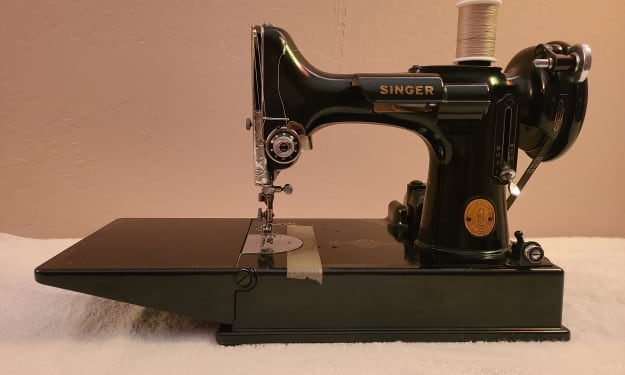
Cloth has a “feel” to it. It has warp and weft, the weave that gives it heft and weight and texture. Aah – texture. I love texture. Is it smooth and silky? Is it coarse and rough? Every fabric has its own story to unfold, to become a garment, or a quilt, or a baby blanket.
My mother sewed. And repaired – holes in pants, missing buttons, broken zippers. Relatives would drop off their damaged garments and Reggie would fix ‘em. The soft drone of her sewing machine, rarely idle, weaves through my earliest memories. She had boxes and boxes of fabrics and buttons and zippers from decades of projects, and leftovers from cannibalized clothing that became donor parts for mending. The cartons were stacked floor to ceiling on the longest wall of her bedroom, with more boxes stored in the basement. I imagine my mother at three or four, watching my grandmother’s spinning wheel transform strands of flax into smooth, thin, perfectly even thread. While patiently pedaling and spooling the strands, Grandmother would listen to her children recite their school lessons at her feet.
Mom didn’t directly teach me about sewing. But it was omnipresent in my life, with the whirring machine humming handmade clothes into life. She mounted the foot pedal onto the sewing cabinet, next to her right knee, so it wouldn’t shift around on the floor. She was proficient at controlling that pedal with her knee. It was years before I realized that this was something she ingeniously invented herself and that no one else had a “knee pedal”.
Mom enjoyed sewing so much, but didn’t like cutting out fabric from patterns. When I was available, she would ask me to do the precision cutting necessary, which was something I was very good at, and she would take it from there. She did, however, have strong opinions on how to lay out the pattern pieces onto the fabric and often strayed from the recommended layout in the instructions. “They waste too much fabric,” she would say, and then add the bonus fabric saved into one of her boxes. Also, she could be impatient, and would often have to rip seams apart and reconstruct them to correct mistakes. Mom’s garments were notoriously known for all the loose ends of threads left inside from these modifications.
When I went to High School, I took four years of sewing classes. I learned basting and hand-made buttonholes and matching plaids in a seam and cutting on the bias. My Senior year I tailored my own double-breasted winter coat made out of brown wool and heavy satin lining. It had a large hood and a buttoned half-belt in back over a center vent. Between the outer wool and interior lining, there were all sorts of “secrets” that made this coat rival haute couture. There were facing and interlining and hand-sewn hems and understitching used to keep the collar and lapels properly rolled under. I followed the pattern precisely and tidily snipped away any stray threads.
While I was raising children, I didn’t sew much. But my oldest daughter, Susan, found an old sewing book of mine at a young age, and taught herself to sew puppets and toy dragons and other fantasy creatures she conjured from my own stash of leftover fabrics. She sewed like my mother, astutely “correcting” patterns and impatiently leaving threads hanging in her fervor to create. In her middle school years, we did creative projects together, including entering items into the San Mateo County Fair. Her first County Fair entry was a big stuffed walrus made of fur that she hand-sewed and she won a blue ribbon for it. She made a cute sheep family the next year, this time machine-sewn. Now, as a director and teacher at an Arts Studio, she teaches kids to sew. There’s an upstairs room with several sewing machines and young children come and create their own works of art with fabric.
It’s particularly fulfilling to create something special out of a simple, flat piece of fabric. Whether it’s fashioning a tailor-fitted garment to wear or fabricating draperies that dress up a window, there’s a sense of achievement in this handiwork.
Although seemingly by happenstance, as there didn’t seem to be direct passing down of this ancient craft, I feel the legacy of bringing works of cloth art into existence is the thread that weaves together the women of this family. To me, this shared skill gives heft and weight and texture to our shared genetic code and is the tie that binds Great-Grandmother, Grandmother, Mother, and Daughter.
About the Creator
Ruth Sieber
Stage performer, aspiring writer and artist






Comments
There are no comments for this story
Be the first to respond and start the conversation.